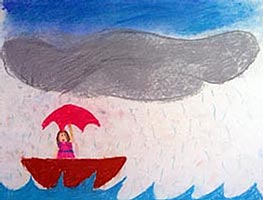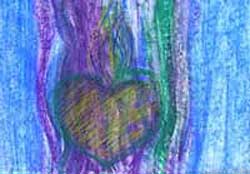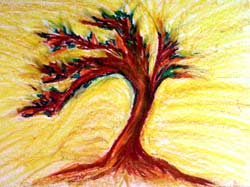|
|
| Hello, and
thank you for your visit to candacenenglish.com. With this
website I am trying to put some of my concepts and ideas as
a therapist out for consideration, including how I use art
therapy in my work.
Every therapist has essentially the same
goal: to help people change in order to relieve their distress.
But how is a client to know which practicioner would be a
good match? Of course, a referral, or seeking out someone
who identifies with your problem or population can be a good
start. But interestingly, outcome studies have shown that
regardless of the theoretical orientation, specialty or license,
positive results are actually based upon the bond of trust
and mutual acceptance that develops between therapist and
client.
In my practice of psychotherapy, we are
seeking to create a process of transformation. It is a journey
derived from the unique needs and inclinations of each client
and sought collaboratively through the client-therapist relationship.
As you read through this page and browse other pages of the
site, I hope you will begin to get a feeling for who I am
as a therapist, and how the journey might proceed with clients
in the different stages of life.
|
|
• Children
The work I do with children is experiential and grounded in
the art of play. It works from the assumption that play can
be a metaphor for the conflict or fear which the child needs
to express. The process is one of deeply listening to the child,
following and being willing to take a secondary role as the
child gains a sense of control and safety.
My greatest influence is Viola Oaklander’s
work and her ground-breaking writings, including "Windows
to Our Children". I believe she is right in her
assertion that many of the diagnoses associated with anti-social
and hyperactive behaviors are actually impulse control problems.
Many of us become angry and feel an impulse to lash out. The
ability to control aggressive impulse, to process it successfully
through metaphor, can be practiced in the play setting where
the child feels comfortable and curious.
Children and adolescents who have problems with
anger or depression, may also display a special sensitivity,
a developmental eccentricity or even an extraordinary gift.
These factors may contribute to their inability to cope with
feelings of hurt and frustration. In addition, there is likely
to be an environmental aspect--a discord or perceived threat
in the environment that is provoking him or her. As Oaklander
says, ‘the resulting behaviors, which are often perceived
as anti-social by adults, are actually a desperate attempt
to reestablish a social connection.’ |
|
• Adolescents
A lot has been written in an attempt to explain
the “teenager”. The process of adolescence is
set in motion by profound physiological changes. In some populations
these changes may begin as early as 9 years old. While transition
and transformation are characteristics of puberty in every
culture, the phenomena of rebellion and alienation appear
to be more prominent in Western consumer-oriented societies.
Some of the issues that bring teens into counseling include
problems with parents and peers, academic failures, conduct
problems, eating disorders, alienation, depression, drugs
and alcohol, sexuality and questions around sexual preferences.
As a therapist, my initial goal is to provide
a young person the opportunity to express conflicting or amazing
thoughts in a safe and neutral context. To do this requires
the client’s trust. Building trust with a teen client
is all about patience, consistency, confidentiality and a
non-judgmental response. |
|
• Adult Individuals
The term adulthood spans at least three life
phases, according to most theories of development. While the
issues and priorities of young adulthood are far different
from those of old age, still the oppressive themes of loss,
grief, guilt, anger and regret touch everyone’s life
at one time or another. Sometimes these themes are awakened
and brought to the forefront by life-changing events such
as a separation, illness, caregiving or reversal of fortune.
The feelings associated with these events are frequently what
bring adult clients to seek counseling.
My practice includes old and young, gay and
straight, partnered folks and dedicated singles. Most of the
work is about becoming whole through building the core of
selfhood; and developing a knowledge of self care that is
viewed as the foundation of our reaching outward to others
and to our world. Conversation is a big part of this work,
but the approach I take as a therapist includes and goes beyond
traditional talk therapy. Embracing the clients’ own
gifts or inclinations in the process, we work together to
carefully craft the experiences of imagining, art making,
writing or enacting that will play an important role in creating
real and lasting change. |
|
• Couples
The great diversity of couples’ relationships is a testament
to how fundamental is this basic unit of society. The Marriage
and Family Therapist License in California limits the scope
of practice to relationship work. When you think about the role
of relationships in the development of the human being, it’s
clear that the MFT scope of practice is broad indeed. That special
training in matters of human interaction and the heart makes
us uniquely qualified as couples counselors. Most people want
meaningful relationships that include companionship, trust,
compassion and a form of closeness that resonates with the body.
Inevitably, the act of forming a couple means that folks are
bringing together different family cultures, with all the challenge
and frustration of reaching beyond the familiar. Family culture
is where we first saw and experienced the dyadic roles played
out. Without doubt we do build some relationships, in part,
out of those early memories. Of those, what strengths of the
family of origin have we brought into our relationships of today?
And which of its dysfunctions are being repeated? For the therapist,
the dance of couples’ therapy is being in the middle but
out of the way. For all concerned, couples therapy will demand
respect, commitment, perspective and humility.
|
|
• Families
Family Therapy views the family as a system in delicate balance,
where each member plays his part of the whole, and where what
affects one will ultimately affect all. Often when a family
comes to therapy, it is because one of the children is having
problems. Rather than pathologizing this child, known as the
identified patient, family therapists see him or her as the
one who is carrying the symptom of the family’s imbalance.
As a student of family systems therapies, I have been particularly
attracted to the work of Virginia Satir, sometimes called
Experiential Family Therapy. The Satirian approach is warm,
directive and playful, with an emphasis on the practice of
communication in several forms. Changing the form of the communication
helps the family to move beyond the ‘content’
and reflect on their ‘issues’ more with an eye
to uncovering their own unique processes. For example, we
look at the different roles and alliances portrayed within
the family and what these really communicate.
While many clients do reach new levels of understanding as
a result of verbal exchanges with therapists, I have seen
that it can sometimes be difficult to hold on to these gains
or apply them in one’s life. Experiential Family Therapy
includes the notion of “anchoring gains” by taking
the clients through a series of experiential interventions.
The intent is to bring new conclusions and changes to a deeper
level. These interventions may take several forms, such as:
telling family stories, charting milestones, sharing photos,
doing family art projects, playing board games, or Satir’s
unique creation: family sculpting. The idea is to weave spoken
word together with the creation of images and/or corporeal
actions.
top ^ |
|
|








